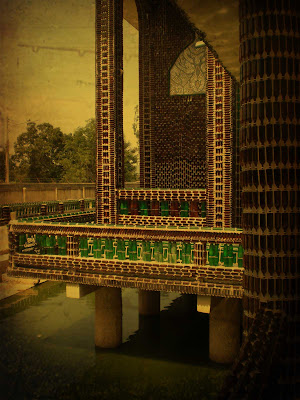











All of the mountains have cave entrances and numerous tunnels, and it is possible to climb to the summit of one of the peaks. The subtle, lyric and poetical ambience of pagodas, grottoes, trees, bushes, sounds the mixed of pagoda bells and murmuring waves and the mysterious legends of sea makes the mountains a fairy land for tourists for ages.
Almost two hundred years ago, King Minh Mang came here. He named the mountain, grottoes and pagodas. Nobody knows why names such as Ngu Hanh Son, Huyen Khong, Hoa Liem, Lang Hu, Tang Chan, Van Nguyet, Thien Long put King deep in thought, despite of dwelling on to national development, the King kept in his mind the picturesque landscape of the mountains as the pride of the beautiful southern land.
Cultural and historical stamps can be seen on every pagoda and tower built in the 19th century, and on Champa sculptures of the 14th and 15th century. There are written-on-stone poets of the Le and Tran Dynasty, a grave of Capital Tran Quang Khai’s mother, a temple worshiping Ngoc Lan princess (Minh Mang King’s younger sister) and such evolutionary relics as Da Chong tunnel, Ba Tho cave, Kim Son mount, Am Phu cave, etc… All are persuasive evidences to the legendary Marble Mountain and the land endowed with the people of great talent.
The Marble Mountains, also referred to as Ngu Hanh Son or Mountains of the Five Elements, consist of five marble mountains: Thuy Son (water) which is the highest, Moc Son (wood), Kim Son (metal), Tho Son (soil), and Hoa Son (fire). Like other landscapes, these mountains have many different mysterious legends. The poetical ambience plus echoes of my mysterious legends gives mountains their own characters that it is difficult to find on other places. In ancient oriental philosophy; metal, wood, water, fire, earth were five elements that created the universe. Five is the paramount important number in thinking and lives. The coincidence of the five peaks: metal, wood, water, fire, earth still keeps them mysterious.
Among these, Thuy Son has been exploited as a popular tourist resort because of its alluring beauty. Stone steps carved into the mountain lead to the Tam Thai Pagoda where Phat Di Lac is worshipped. At the back of the pagoda is Huyen Khong Cave. In the past, the pagoda paid tribute to Hindu and Buddhist gods and is now dedicated to Cham deities. Huyen Khong Cave was the base for Vietnamese revolutionaries during wartime.
The natural grottoes and pagodas on the mountains combine both heaven-endowed and man-made to create the harmonious beauty. The feature the attractive characters that keep tourists surprised and emotional on the way traveling.
Moreover, the Marble Mountains are famous for traditional stone engraving activities. In Dong Hai Village close to Thuy Son, 600 families chisel stone producing statues, jewelry, and art work. Stone from the Marble Mountains has been exported to many countries.




































